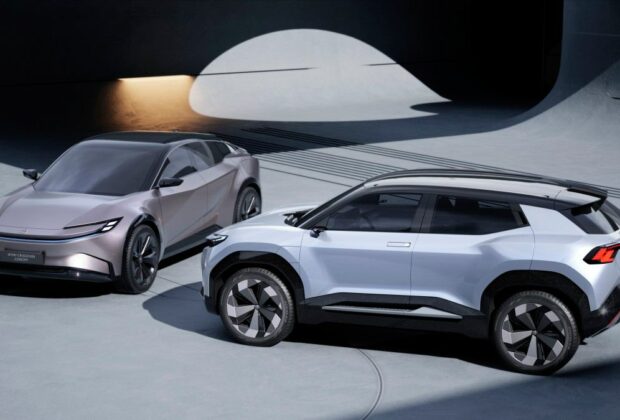The European division disclosed some of the details of the multipathway strategy for carbon neutrality adopted by the corporation last week.
The largest carmaker in the world based on sales, Toyota, declared last year that it aimed to be completely carbon neutral in Europe by 2040. By 2030, all of its European facilities would be carbon free, and throughout the next ten years, all of its cars would be fully carbon neutral.
Notwithstanding the company’s well-established belief in the benefits of hybrid cars, a portion of this entails growing its lineup of fully battery-electric cars in Europe.
On Saturday, September 16, 2023, at the North American International Auto Show (NAIAS) in Detroit, Michigan, the United States, the 2024 Jeep Grand Cherokee 4xe electric sports utility vehicle (SUV). Over 20 attractions, activities, and performances regarding cars and the rapidly advancing technology that powers them are on display during the event.
Toyota Europe’s goal for 2026 is 15 emission-free cars
The carmaker stated in a statement on Monday that 71% of its vehicles in Europe are currently electrified, and that percentage is predicted to rise to 75% by the following year.
By 2026, Toyota plans to increase the number of zero-emission vehicles it offers in Europe to 15, bringing the percentage of BEVs in the region up to 20%.
Yoshihiro Nakata, president and chief executive of Toyota Motor Europe, stated in a statement, “We will continue to offer multiple carbon reduction technologies, and we will also steadily increase the number of zero-emissions vehicles we offer to customers.”
The business unveiled a number of new totally electric models on Monday that will be added to its European fleet by 2026.
Toyota also introduced concepts for a Sport Crossover and an Urban SUV in addition to the BZ4X, which is now available for purchase, and the Compact SUV concept that was unveiled the previous year.
Referring to the SUV as a “close-to-production design,” the manufacturer stated that it will make its debut in one of the biggest EV market categories in Europe the following year. In 2025, the Sport Crossover is expected to hit the market.
Toyota: Batteries of the future
Toyota not only unveiled its new lineup but also highlighted the research and development it was undertaking on next-generation batteries, which the firm claims would transform how cars are “developed, made, and used.”
The business claims that the first of these batteries, which will be available after 2026, will provide a 20% cost reduction and double the range over the existing bZ4X. The second will increase range by 20% and reduce expenses by 40% when compared to the same car since it is built from a less expensive lithium-iron phosphate and has a new shape and structure.
According to Toyota, the third battery in this lineup will improve performance even more at an even lower cost. Specifics on the battery and its anticipated capacity to reduce costs and increase range were not disclosed by the manufacturer.
According to Andrea Carlucci, vice president of Toyota Motor Europe, Toyota’s efforts towards solid-state batteries are also almost complete.
Carlucci claims that the company has “made a technological breakthrough” and is working on a strategy for mass production and 2027 commercialization. The first production capacity that the business anticipates using is “several tens of thousands of vehicles.”
According to Toyota, the third battery in this lineup will improve performance even more at an even lower cost. Specifics on the battery and its anticipated capacity to reduce costs and increase range were not disclosed by the manufacturer.
According to Andrea Carlucci, vice president of Toyota Motor Europe, Toyota’s efforts towards solid-state batteries are also almost complete.
Carlucci claims that the company has “made a technological breakthrough” and is working on a strategy for mass production and 2027 commercialization. The first production capacity that the business anticipates using is “several tens of thousands of vehicles.”
Iran, North Korea, China, and Russia are all included in the phrase.
The guidelines have the potential to increase the price of electric cars and alter the EV supply chain.
“The U.S. controls its own destiny with supply chains and raw materials sourced domestically or from allies,” stated John Bozzella, president and CEO of Alliance for Automotive Innovation, in a blog post on Friday. “This is important (for economic and national security).”
However, the adoption of electric vehicles necessitates a radical overhaul of the American manufacturing sector. It’s an enormous task that will take time to complete.”
China led the world in the production and trade of sustainable energy technologies, including EV batteries, according to a 2023 International Energy Agency assessment. The International Energy Agency (IEA) estimates that China produces more than 66% of the world’s battery cells, with the United States producing only 10% of them.
According to a Treasury statement, Joe Biden “entered office determined to reverse the decades-long trend of letting jobs and factories go overseas to China,” according to John Podesta, the president’s top assistant on clean-energy innovation. “We’re assisting in securing American manufacturing for electric vehicles in the future.”






